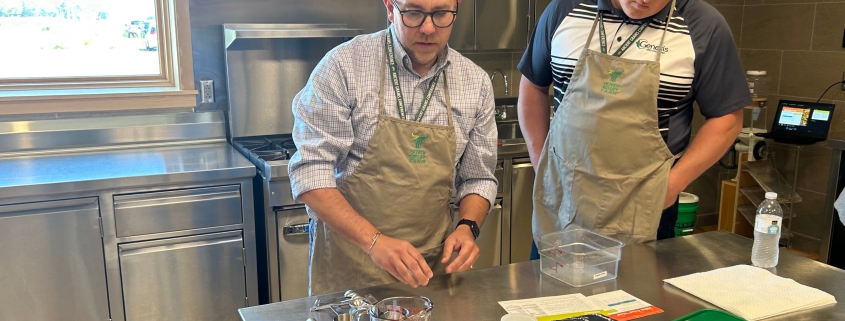Ancient Grains Conference explores trends, challenges, opportunities
While the grains may be ancient, the market for them is growing and evolving. That was the message shared during the second annual Ancient Grains Conference at the Oliver Kelley Farm in Elk River, Minn. SSGA Manager of Strategic Programs Shane Frederick attended the conference, which was hosted by the Northern Crops Institute (NCI) and aimed to provide an educational and promotional setting to explore the characteristics and utilization of ancient grains. Otherwise known as heritage grains, ancient grains include wheat, barley, sorghum, oats, millet, amaranth, flax, teff and more. Presenters offered insight into ancient grains trends, challenges and opportunities, and attendees even had the opportunity to participate in cooking and stone milling demonstrations.
The Ancient Grains Conference also caught the interest of Minnesota Department of Agriculture Commissioner Thom Petersen, who made an appearance at the event.
“I’m interested in anything we can do to diversify our agriculture in this state,” Commissioner Petersen said. “It is apparent consumers are interested in the ancient grains market, and we need to continue to explore other opportunities and capitalize on the trends that we’re seeing currently. The state of Minnesota has a number of resources available to help those in the ancient grains industry be successful.”
Making healthy choices
In her morning keynote, Ardent Mills Director of Specialty Grains & General Manager of Emerging Nutrition Shrene White emphasized that the consumers are more empowered than ever before when it comes making healthy choices.
“They no longer hope to find food that meets their health needs,” White said. “They expect it.”
According to White’s reports, consumers are placing a higher priority on finding foods and ingredients that both taste good and deliver positive aspects to the experience. She also noted that they are willing to pay for it as well. Sales for sandwich bread and cereal/granola bars with an Ancient Grains label are up 6.5% and 3.1%, respectively, despite those units costing more than traditional varieties. However, there is still room for growth. White emphasized a need for the ancient grains community to capitalize on the momentum, align with other grains and continue to educate and communicate in order for ancient grains to become a sustainable solution in the marketplace.
Trending in the right direction
During a panel discussion on Growing Ancient Grains in the Market, Laurie Scanlin, principal scientists at the Ardent Mills Innovation Center, highlighted that ancient grains have grown from a niche market into nationwide commercialization.
“A few decades ago, ancient grains and quinoa and flax could only be found in health food stores,” she said. “Now every grocery store in the country is carrying them, and products that include them are proud to market that whole grain or ancient grains affiliation.”
Kelly LeBlanc, Oldways vice president of nutrition programming, indicated that the whole grains trend will continue as consumers are still looking for products that are indictive of good health and sustainability. Specific ancient grains that are trending upward include millet, amaranth, teff and quinoa.
Growing the Midwest value chain
The final panel discussion during the conference focused on the Artisan Grain Collaborative between Mark Askegaard and his daughter Beth McConnon, who grow organic wheat south of Moorhead, Minn.; Patrick Wylie of Baker’s Field Flour & Bread, who mills Askegaard’s wheat; and Laune Bread co-owner Chris MacLeod, who uses the flour in his bakery. The partners showcased the benefits of a farm-to-fork partnership and how the end user benefits from the partnership as well.
“Our customers value that we talk directly to people growing our product,” Wylie said. “As a result, our customers have also become more knowledgeable about farming because we communicate with them every step along the way.
Wylie also added that, as a miller, he and his customers value the sustainable farming practices that the Askegaards incorporate into their farm.
“It ensures that the land that the wheat is grown on will continue to be productive for years to come,” Wylie said, “which assures to us that we can also continue to sell a good, quality product to our consumers for years to come as well.”
Wylie hopes that there are more bakeries, mills and farms willing to participate in the Ancient Grains Collaborative so that they can continue to build the market.
A diverse group
The diversity of the small grains industry was well represented during this year’s Ancient Grains Conference, which included participation from mom-and-pop operations all the way to the largest flour mill in the country. While it may seem the giants of wheat industry are competitors with growing markets of ancient grains, this conference proves how they are working together.
“Working within the specialty grains space and supporting that area of agriculture remains a strategic goal of SSGA’s,” Frederick said. “The Ancient Grains Conference was a great way to stay up on trends, including consumers’ growing interests in whole grains – including their willingness to pay a little more for ancient grains claims – in order to meet their food wants and needs. This also aligns with what SSGA is doing with the U.S. Identity Preserved label.”







Leave a Reply
Want to join the discussion?Feel free to contribute!